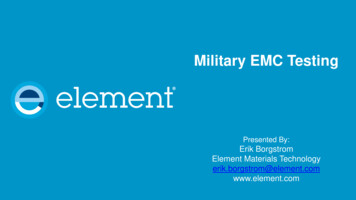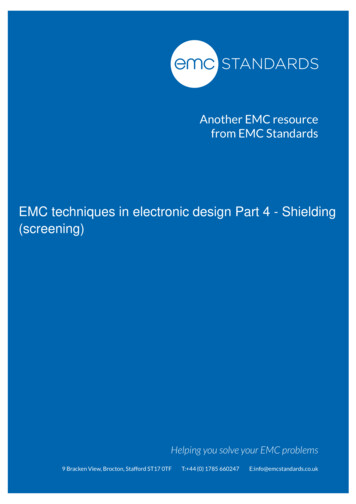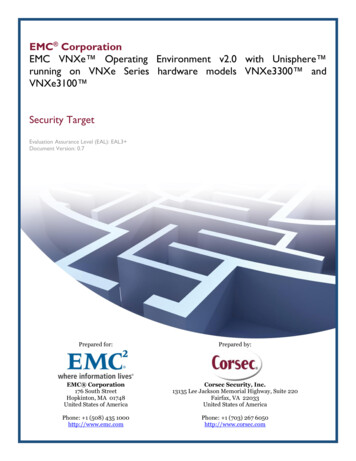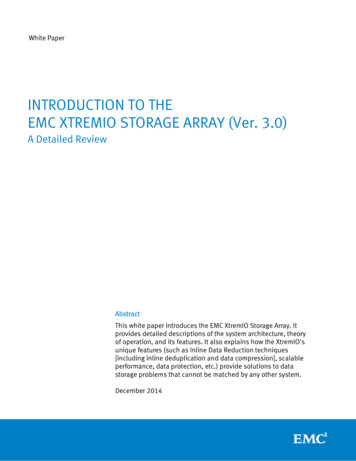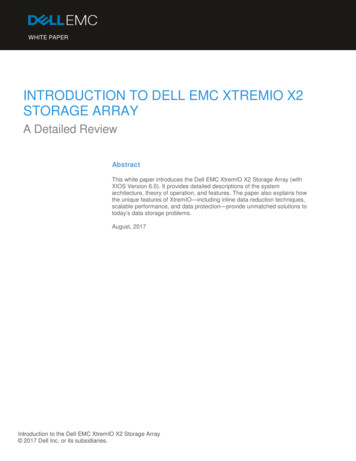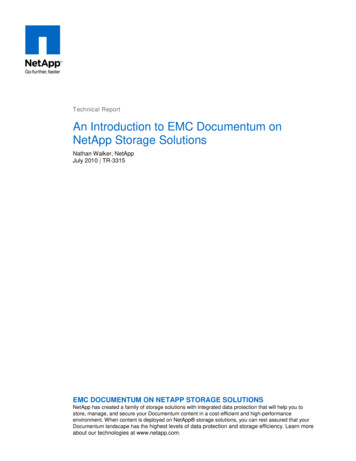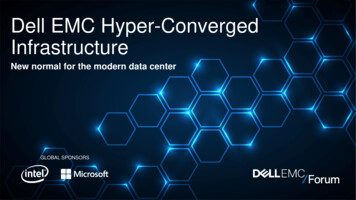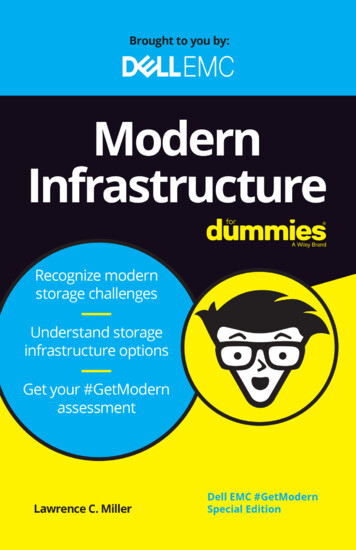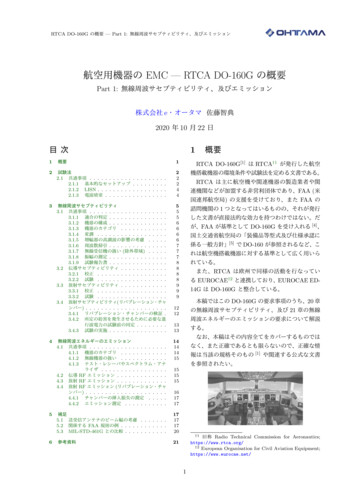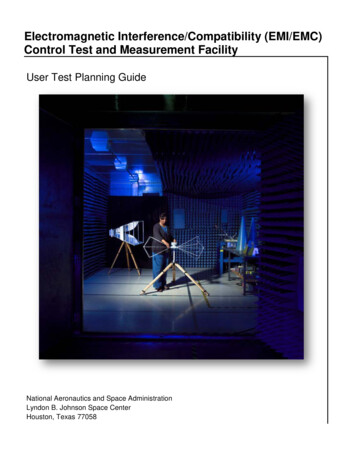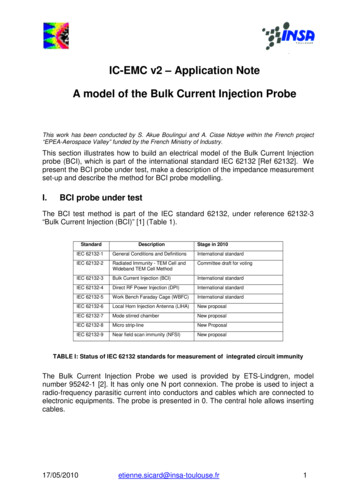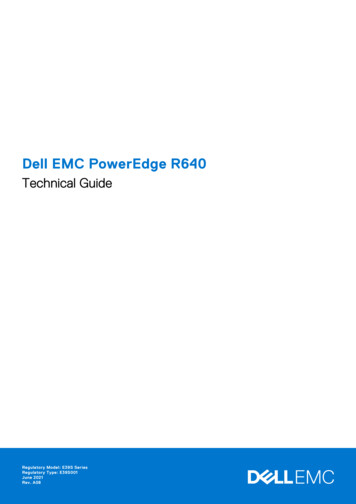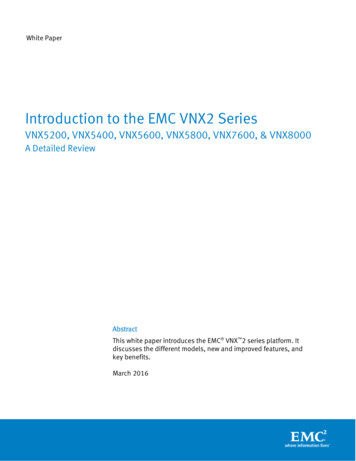
Transcription
White PaperIntroduction to the EMC VNX2 SeriesVNX5200, VNX5400, VNX5600, VNX5800, VNX7600, & VNX8000A Detailed ReviewAbstractThis white paper introduces the EMC VNX 2 series platform. Itdiscusses the different models, new and improved features, andkey benefits.March 2016
Copyright 2016 EMC Corporation. All rights reserved.EMC believes the information in this publication is accurate of itspublication date. The information is subject to change withoutnotice.The information in this publication is provided “as is.” EMCCorporation makes no representations or warranties of any kindwith respect to the information in this publication, andspecifically disclaims implied warranties of merchantability orfitness for a particular purpose.Use, copying, and distribution of any EMC software described inthis publication requires an applicable software license.For the most up-to-date listing of EMC product names, see theEMC corporation trademarks page at EMC.com.VMware is a registered trademark of VMware, Inc. All othertrademarks used herein are the property of their respectiveowners.Part Number: H12145.9Introduction to the EMC VNX2 Series – A Detailed ReviewVNX5200, VNX5400, VNX5600, VNX5800, VNX7600, & VNX80002
Table of ContentsExecutive summary . 5Audience . 5Terminology . 5VNX family overview . 8VNX hardware components . 9Configurations . 10Components and features in the VNX2 . 14Xeon E5 processor . 14Li-Ion SPS, BBUs, and power . 14High-capacity and small form factor drives . 15New Control Station . 15DAEs, DPEs, and drives provide increased density . 156 Gb/s x 4 lane and 6 Gb/s x 8 lane SAS back-end. 31Expanded UltraFlex I/O using PCI-E Gen 3 increases bandwidth . 31VNX2 models . 32VNX5200 . 34VNX5400 . 38VNX5600 . 39VNX5800 . 40VNX7600 . 41VNX8000 . 42VNX Gateway . 48I/O modules . 49I/O modules for the Storage Processor. 49I/O modules for the Data Mover . 56Control Station . 61Software on the VNX2 series . 62MCx . 62Reserved area on VNX2 series storage systems. 64Unified management . 64Software for efficiency . 66Fully Automated Storage Tiering for Virtual Pools (FAST VP) . 66Multicore FAST Cache. 67Deduplication and compression . 68Windows 8.1 and Server 2012 R2 . 72Virtual Data Movers (VDMs) . 74Thin Provisioning . 75Introduction to the EMC VNX2 Series – A Detailed ReviewVNX5200, VNX5400, VNX5600, VNX5800, VNX7600, & VNX80003
Software for protection . 76VNX Replicator . 76RecoverPoint integration . 77MirrorView/A . 77MirrorView/S . 77VDM MetroSync . 79SAN Copy . 80Business continuance. 81SnapView snapshots . 81SnapSure checkpoints . 82SnapView clones . 82Security . 83Data-At-Rest Encryption . 83Anti-virus software . 84Quota management and auditing. 84File-Level Retention. 84Advanced Data Services support for file . 86Serviceability, availability, and performance . 87Unisphere one-button shutdown. 87Unified software upgrade . 88Unified remote support . 89Block-to-Unified upgrades . 89Data-in-Place conversions. 90VNX2 scalability and performance . 91Conclusion . 92Appendix A: System, block, and file level components. 93Appendix B: Storage processor UltraFlex I/O slot availability. 97Introduction to the EMC VNX2 Series – A Detailed ReviewVNX5200, VNX5400, VNX5600, VNX5800, VNX7600, & VNX80004
Executive summaryPower, efficiency, protection, and simplicity are four traits that must characterize an arrayin today’s high demand storage environment. Storage systems are required to providepowerful and efficient storage technologies, keep data protected, and be simple to useand manage.The VNX multicore initiative, MCx , is an architecture project that redesigns the coreBlock OE stack within the new VNX series (VNX2). Developed with many goals, the MCxplatform’s most significant mission is CPU Scaling. This mission is very simple: takeadvantage of the many CPU cores that the Intel microarchitecture offers and create asolution for further technological growth.The VNX2 platform is a union of increased hardware performance and the extensive codechanges required to support it. The optimization focuses on ensuring that cachemanagement and back-end RAID management processes take full advantage of multicoreCPUs, allowing cache and back-end processing software to scale in a linear fashion. Inthis way, EMC fully leverages the power of Intel’s latest multicore CPUs. The VNX2 serieshas a scaling factor of 97 percent, so future scaling using additional cores is guaranteed.This not only allows EMC to deliver cost efficient performance, but also to scale whiledelivering advanced efficiency and protection.The VNX2 series is designed for a wide range of environments from mid-tier to enterprise.Each VNX2 model is offered in file only, block only, and unified (block and file)implementations. The VNX2 series is still managed through a simple and intuitive userinterface called Unisphere ; this single pane of glass completes the unified experience.This white paper discusses the VNX2 series models (VNX5200 , VNX5400 ,VNX5600 , VNX5800 , VNX7600 , and VNX8000 ), their hardware and software,limits, I/O modules, and more. This paper also describes the software, serviceability, andavailability features of the VNX2 platform, such as MCx, Block Deduplication, FAST ,Data-At-Rest Encryption, Windows 8.1/Server 2012 R2 support, One Button Shutdown,and Unisphere Service Manager.For details on the VNX5100/VNX5300/VNX5500/VNX5700/VNX7500 models, refer to thewhite paper titled Introduction to the EMC VNX Series – VNX5100, VNX5300, VNX5500,VNX5700, & VNX7500: A Detailed Review, available on EMC Online Support.AudienceThis white paper is intended for IT architects, administrators, and others who areinterested in the VNX2 series arrays. It assumes familiarity with storage array concepts,general hardware, and the software services provided by the arrays.TerminologyAutomatic Volume Management (AVM)—Feature of VNX File Operating Environment (OE)that creates and manages volumes automatically without manual volume managementIntroduction to the EMC VNX2 Series – A Detailed ReviewVNX5200, VNX5400, VNX5600, VNX5800, VNX7600, & VNX80005
by an administrator. AVM organizes volumes into storage pools that can be allocated tofile systems.Converged Network Adapter (CNA)—Host adapter that allows a host to process FibreChannel and Ethernet traffic through a single type of card and connection, decreasinginfrastructure costs over time.Disk Array Enclosure (DAE)—Shelf in a VNX2 that includes: an enclosure; either 15, 25,60, or 120 disk modules; two SAS link control cards (LCCs) or InterConnect Modules(ICMs); and two power supplies. It does not contain storage processors (SPs).Disk Processor Enclosure (DPE)—Shelf in the VNX2 that includes: an enclosure; diskmodules; storage processors (SPs); two base modules; two battery backup units (BBUs);two power supplies; up to ten I/O modules; and four fan packs. A DPE supports DAEs inaddition to its own disk modules. This 3U form factor is used in the VNX5200 ,VNX5400 , VNX5600 , VNX5800 , and VNX7600 . It supports a maximum of 125, 250,500, 750, and 1,000 drives, respectively.Base Module—Part of the VNX2 DPE, a single base module contains two Serial-attachedSCSI (SAS) back-end ports, one power supply, and one battery backup unit (BBU).Fibre Channel (FC)—Gigabit-speed data transfer interface technology. Data can betransmitted and received simultaneously. Common transport protocols, such as InternetProtocol (IP) and Small Computer Systems Interface (SCSI), run over Fibre Channel.Consequently, a single connectivity technology can support high-speed I/O andnetworking.Fibre Channel over Ethernet (FCoE)—Allows Fibre Channel frames to be encapsulated viaEthernet. With Converged Network Adapter cards, a host may use one type of adapter andcable for Ethernet and Fibre Channel traffic.Flash drive—Flash drives provide extremely high performance and consume very littlepower. These drives enable a VNX2 to provide an Extreme Performance level of storagefor critical workloads. Flash drives can also extend the array’s cache using FAST Cachetechnology.Fully Automated Storage Tiering for Virtual Pools (FAST VP)—Advanced data service thatrelocates data of pool-based LUNs at a sub-LUN level to optimal locations within astorage pool.Logical Unit Number (LUN)—Identifying number of a SCSI or iSCSI object that processesSCSI commands. The LUN is the last part of the SCSI address for a SCSI object. The LUN isan ID for the logical unit, but the term often refers to the logical unit itself.MCx—Multicore initiative (Multicore Cache, Multicore FAST Cache, Multicore RAID) andre-architecture project that redesigns the Block OE stack within the VNX2 series. MCxdelivers core functionality improvements making the VNX Block OE more robust, reliable,predictable, and easier to use than ever before.Introduction to the EMC VNX2 Series – A Detailed ReviewVNX5200, VNX5400, VNX5600, VNX5800, VNX7600, & VNX80006
Multicore Cache—VNX array cache (sometimes referred to as DRAM Cache) is an MCxsoftware component that increases host write and read performance by using the VNX2Storage Processor’s DRAM.Multicore FAST Cache—Large capacity secondary cache that uses enterprise Flash drives.Multicore RAID—MCx component that defines, manages, creates, and maintains VNX2RAID protection.Near-Line Serial Attached SCSI (NL-SAS) drives—Enterprise SATA drives with a SASinterface head, media, and rotational speed of Enterprise SATA drives with a fully capableSAS interface. These drives provide similar performance and capacity to SATA drives,utilizing a SAS interface for I/O.Serial-attached SCSI (SAS)—Communication protocol used to move data to and fromcomputer storage devices. SAS is a point-to-point serial protocol that replaces parallelSCSI bus technology. Expanders facilitate the connection of multiple SAS end devices toa single initiator port.I/O Module—A hardware component that provides front-end and back-end connectivitybetween the storage processors disk-array enclosures, and hosts.Storage Processor Enclosure (SPE)—Shelf in the VNX2 that includes: an enclosure;storage processors (SPs); up to twenty-two I/O modules; four power supplies; and tenfan assemblies. This 4U form factor is used for the high-end VNX8000 and supports amaximum of 1,500 drives.Storage Pool—Single repository of homogeneous or heterogeneous physical disks fromwhich LUNs may be created. This concept enables ease of use and technologies such asFAST VP.Introduction to the EMC VNX2 Series – A Detailed ReviewVNX5200, VNX5400, VNX5600, VNX5800, VNX7600, & VNX80007
VNX family overviewThe VNX family includes the VNXe , VNX, andVNX2 series arrays. The VNXe series isdesigned for small-to-midsize storage environments, while the VNX series is designed formidtier-to-enterprise storage environments.The VNX2 series is EMC’s next generation of midrange-to-enterprise products. The VNX2series utilizes EMC’s VNX Operating Environment for Block & File that you can managewith Unisphere, a simple, easy to use management framework. This VNX2 softwareenvironment offers significant advancements in efficiency, simplicity, and performance.The VNX2 series includes six models that are available in block, file, and unifiedconfigurations: VNX5200 VNX5400 VNX5600 VNX5800 VNX7600 VNX8000There are two existing Gateway models: VNX VG2 VNX VG8There are two VMAX Gateway models: VNX VG10 VNX VG50The VNX2 series offers: State-of-the-art hardware: PCI-E Gen 3 I/O modules 6 Gb/s x 4 lanes SAS back-end infrastructure Up to x 8 wide (6 Gb/s x 8 lanes) high-bandwidth connection to 60 drive DAEwith new 6 Gb SAS I/O module Increased memory and core optimization with MCx Intel’s latest Xeon E5 multicore processors Expanded UltraFlex I/O, delivered with denser packaging NEBS (Network Equipment-Building System) certified DC-powered arrays(VNX5200, VNX5400, & VNX5600)Introduction to the EMC VNX2 Series – A Detailed ReviewVNX5200, VNX5400, VNX5600, VNX5800, VNX7600, & VNX80008
Block functionality that supports the FC, iSCSI, and FCoE protocols File functionality that supports the NFS, CIFS, and pNFS protocols Support for up to 1,500 drives Ultra-dense 120-drive DAE Automated tiering with Fully Automated Storage Tiering for Virtual Pools (FAST VP) forblock and file data Controller based, drive level, Data-At-Rest Encryption Updated unified management with Unisphere delivers a cohesive, unified userexperienceVNX hardware componentsVNX2 storage systems include these hardware components: Storage Processors (SPs) support block data with UltraFlex I/O technology thatsupports Fibre Channel, iSCSI, and FCoE protocols. The SPs provide access for allexternal hosts and the file components of the VNX array. The Storage Processor Enclosure (SPE) is 4U in size and houses dual storageprocessors. This form factor is used for the high-end VNX8000 model. It does notcontain any onboard drive slots and requires the use of DAEs, supporting a maximumof 1,500 drives. The Disk Processor Enclosure (DPE) is 3U in size and houses dual storage processorsand the first tray of disks. Mid-to-high-end VNX2 models (VNX5200, VNX5400,VNX5600, VNX5800, and VNX7600) use this form factor. It contains 25 x 2.5”onboard drive slots and supports a maximum of 125, 250, 500, 750, and 1000drives, respectively. Blade (or Data Mover) accesses data from the back end and provides host accessusing the same UltraFlex I/O technology that supports the NFS, CIFS, and pNFSprotocols. The blades in each array are scalable and provide redundancy. The Data Mover Enclosure (DME) is 2U in size and houses the Data Movers (Blades).All file and unified VNX models use at least one DME. Li-Ion Standby Power Supplies (SPSs) are 2U in size and used only in the VNX8000.There are two SPSs in a VNX8000 array. Each SPS has two batteries. One SPSprovides backup power to the SPE, and the second to the first DAE. These SPSsprovide enough power to each storage processor and first DAE to ensure that any datain flight is de-
Introduction to the EMC VNX2 Series – A Detailed Review 5 VNX5200, VNX5400, VNX5600, VNX5800, VNX7600, & VNX8000 Executive summary Power, efficiency, protection, and s
